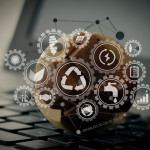
Using only air and high temperatures, the new method can extract various metals from electronic trash.
The Challenge of Extracting Metals
More than half of essential minerals used in electronics, such as gold and rare earth metals, are thought to wind up in landfills. This is partially due to the difficulty and expense of current procedures for extracting and purifying metals. Furthermore, the procedures involve the use of caustic chemicals or extremely high temperatures of about 1,800 degrees Fahrenheit (980 degrees Celsius), both of which are harmful to the environment.
Materials scientist Martin Thuo and his collaborators at Iowa State University demonstrated a new method of extracting valuable metals from recycled electronics in a paper published in the journal Materials Horizons in March 2021. The method requires only air and relatively low temperatures of 500-700 degrees Fahrenheit (260-370 degrees Celsius).
New Focus On Simpler Solutions
Thuo explained that simplicity, or ease of use, is the best asset in extracting these metals. “My lab works on frugal technologies, and this method is one of a set that we are developing to recover metals from mixed-metal waste.”
The technique makes advantage of the waste metals’ relative reactivity. When exposed to air, the more reactive a metal is, the faster it will oxidize (bond with oxygen to create an oxide). The oxidation process begins near the surface, where the most reactive component’s atoms initially bond to oxygen. A protective coating of oxidized metal will eventually develop, preventing further oxidation. To encourage the various metal ions in the sample to disperse, Thuo and his colleagues employ a balance between the quantity of air in the environment and the temperature of the environment: when the most reactive reach the surface, they oxidize and stay there. Due to their significantly higher density, the oxides may then be physically separated from the remainder of the waste material.
“If you are increasing the temperature, you’re encouraging diffusion,” Thuo explained. “Materials aren’t static; their ions are constantly diffusing in a proportionate quantity to temperature. All you need to do is help them move around, and then you can pull them out.”
A New Way
This novel approach has the advantage of being adaptable, allowing various metals to be extracted from a sample one by one. The temperature and air balance determine which waste component reacts first. The most reactive component is removed from the remainder of the sample after it has completely oxidized, and the procedure is repeated with the next reactive component. In the end, only the least reactive metals are left.
The process’ tunability also necessitates “profiling” the waste beforehand, in order to calculate the quantity of each component and plan the air and temperature adjustments correspondingly. As his team attempts to commercialize the technique, Thuo said fine-tuning these profiles, as well as defining the method’s environmental friendliness and cost, would be a top focus.
The discovery has “huge promise,” according to peers in the industry. Its distinct viewpoint in the realm of recycling and separation which normally uses harsh chemicals is an exciting breakthrough, one many are looking forward to seeing put to use in real e-waste scenarios. Thuo promises to continue looking into additional options to supplement the adjustable thermal-oxidative process described, and pushing boundaries of traditional recycling and up-cycling processes.
Related news: Secure E-waste Export and Recycling Act Proposed in the USA
TechWaste Recycling directly services all of Southern California and provides pickup services to its facilities from nationwide locations. Visit TechWaste Recycling’s website at www.techwasterecycling.com to schedule a pickup that works for your convenience and schedule.


































